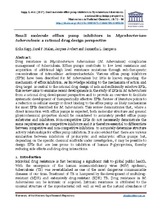Small molecule efflux pump inhibitors in Mycobacterium tuberculosis: a rational drug design perspective

View/
Date
2018Author
Kapp, Erika
Malan, Sarel F.
Joubert, Jacques
Sampson, Samantha L.
Metadata
Show full item recordAbstract
Drug resistance in Mycobacterium tuberculosis (M. tuberculosis) complicates management of tuberculosis. Efflux pumps contribute to low level resistance and acquisition of additional high level resistance mutations through sub-therapeutic concentrations of intracellular antimycobacterials. Various efflux pump inhibitors (EPIs) have been described for M. tuberculosis but little is known regarding the mechanism of efflux inhibition. As knowledge relating to the mechanism of action and drug target is central to the rational drug design of safe and sufficiently selective EPIs, this review aims to examine recent developments in the study of EPIs in M. tuberculosis from a rational drug development perspective and to provide an overview to facilitate systematic development of therapeutically effective EPIs. Review of literature points to a reduction in cellular energy or direct binding to the efflux pump as likely mechanisms for most EPIs described for M. tuberculosis. This review demonstrates that, where a direct interaction with efflux pumps is expected, both molecular structure and general physicochemical properties should be considered to accurately predict efflux pump substrates and inhibitors. Non-competitive EPIs do not necessarily demonstrate the same requirements as competitive inhibitors and it is therefore essential to differentiate between competitive and non-competitive inhibition to accurately determine structure activity relationships for efflux pump inhibition. It is also evident that there are various similarities between inhibitors of prokaryotic and eukaryotic efflux pumps but, depending on the specific chemical scaffolds under investigation, it may be possible to design EPIs that are less prone to inhibition of human P-glycoprotein, thereby reducing side effects and drug-drug interactions.
